- About 30,000 adult Turks and Caicos Rock Iguanas remain today, scattered over 50 to 60 small islands and cays, causing the species to be listed as Critically Endangered by the IUCN.
- Though small in size, these reptiles play a big ecological role: they are a keystone species, acting as indispensable browsers and seed dispersers in their dune habitat.
- A team of scientists from the San Diego Zoo’s Institute for Conservation Research, led by Dr. Glenn Gerber, has been instrumental in studying the species and working with government, NGOs and the public to conserve it.

Imagine lounging on a white sand beach, clear azure water reflecting the tropical sun against a backdrop of rustling silvery-green palmetto leaves. It’s what most of us would consider the perfect island vacation and an ideal niche for the committed beach bum.
But that spot’s already taken. Your ideal niche is the perfect home for the Turks and Caicos Rock Iguana (Cyclura carinata). The smallest of the fourteen species of Cyclura rock iguanas is a beach and dune specialist native to the Caribbean. It spends its days soaking up the tropical warmth to help digest a diverse vegetarian meal, before performing the duty of landscape architect on the remote cays where it’s still found.
Locally referred to as “guana,” the lizard is endemic to the Turks and Caicos Islands (TCI), a small United Kingdom Overseas Territory that is part of the Lucayan Archipelago. Most of this beautiful island chain is occupied by the Bahamas.
Though this rock iguana is the largest native terrestrial animal in the TCI, its small in size — typically measuring under 65 centimeters (26 inches) in length. Being island dwellers, the animals evolved with virtually no predators, and were not equipped to defend against the introduction of the numerous rats, cats, and dogs which accompanied European colonization.
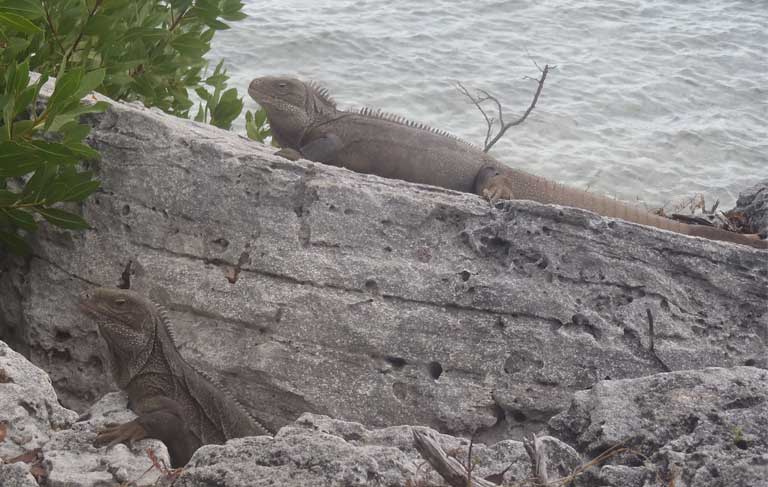
As a result, rock iguanas have been extirpated from nearly all the inhabited islands of Turks and Caicos, along with some uninhabited cays. At least 15 distinct populations have been lost in the last 40 years, primarily due to invasive predators and habitat loss. Today, the species is found on 50-60 of the 200 Turks and Caicos Islands and cays, with approximately 30,000 adult iguanas remaining. This dire situation has earned the species a Critically Endangered listing on the IUCN Red List.
Introduced threats
The two largest extant iguana populations remain on Big Ambergris Cay, a four-square-mile island with a currently stalled, but still planned, luxury residential development; and on the uninhabited and protected cays of East Bay Islands National Park. Though relatively stable, these populations are both still threatened by continued rat predation. The East Bay Islands are plagued by feral cats, as well as by an invasion of Australian pine, Casuarina equisetifolia. The Australian pine spreads rapidly and pushes out the native food plants on which the iguanas depend. The likely restart of construction on Big Ambergris Cay’ housing development is another serious and impending threat, particularly because of increased vehicular traffic.
A study carried out from the 1970s onward documented the fate of the rock iguana population of Pine Cay, where over 27,000 Cyclura carinata were reduced to a level of functional extinction within 20 years due to the introduction of cats to that island.
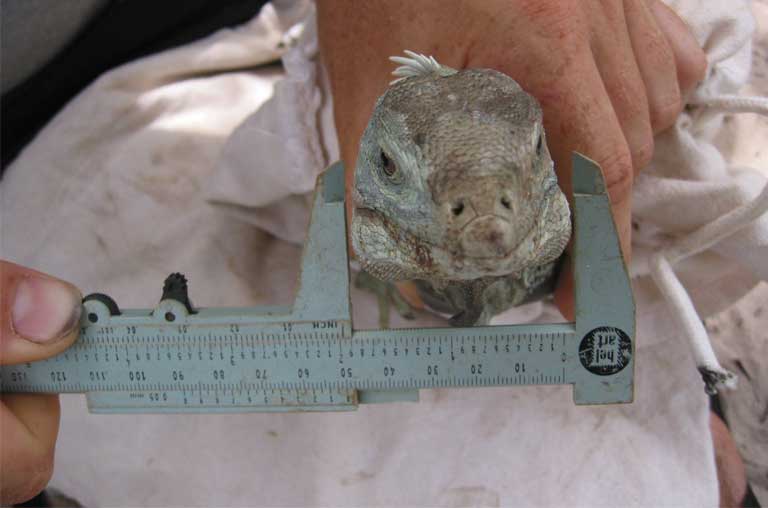
Further studies have linked a 25% reduction in total population over the last two decades to the effects of introduced mammals. On other inhabited islands, functionally extinct remnant populations continue to hang on — where adults that can live to over 50 years persist, but all the hatchlings are killed by predators within their first year.
These remnant adults are also at risk due to habitat loss; the coastal woods and dune habitat favored by rock iguanas are also favored for tourism development. And despite the immense effort put into landscaping tourist resorts and hotels, most are deserts of biodiversity — the relatively few species of ornamental plants that do get planted also get treated regularly with pesticides and fertilizers. These practices have eliminated any usable food for iguanas.
Island gardeners
Though the iguanas reject the sparse resort fare, these reptiles are not terribly fussy eaters. The Turks and Caicos Rock Iguana feeds on well over 100 species of native plants. A 2005 study by the San Diego Zoo focused on finding their favorites; identifying the specific parts of plants selected by iguanas by analyzing the composition of thousands of droppings collected over a period of four years. While the bulk of their diet is composed of leaves from broadleaf evergreen dune species, iguanas also graze tidbits as tiny as palmetto pollen, spurge sepals and grass glumes. Their favorite food is fruit.

With their diverse diet, the animals perform several important ecological functions, continually pruning their dune scrub and thicket habitat, while also spreading seeds. Iguana stomachs act as a short-term seed bank for dune plants by digesting the pulp off the seeds and depositing them around the dunes. C. carinata also provides valuable pest removal services by eating the many tropical insect pests that attack plants and seeds. Despite its small size and relaxed sunbathing habits, Cyclura carinata has turned out to be a very effective dune gardener.
In fact, seeds found in the droppings studied by the San Diego Zoo improved the California zoo’s gardening and husbandry programs. The seeds were planted and grown in the San Diego Zoo’s greenhouses by their horticultural team, then, after being identified, were used to landscape the exhibits of similar rock iguana species, thus offering better forage and habitat for the zoo’s larger collection.
Most of these native island plants depend on the iguanas to spread their seed in the wild — dune plants ranging from prickly pears to sea grapes, bird cherries to dune myrtle, soldier vine berries to darling plums. This seed dispersal also helps to maintain and expand the dunes, allowing plant roots to hold loose sand in place to resist high winds and storm surges, a valuable service that could protect valuable island property as sea levels rise and storms intensify due to climate change.

Merely moving seeds around is not enough for these dutiful dune gardeners. Seeds need to be planted, and the iguanas fulfill that role too. Turks and Caicos Rock Iguanas prefer sandy pockets among the cays’ rocky shores where they excavate extensive burrows to retreat to at night. The movement of so much sand allows the seeds they deposit to be buried for germination.
Via these ongoing behaviors, rock iguanas help propagate and perpetuate a sustainable food source for themselves and their descendants — while also helping to maintain a healthy habitat for other species.
Unfortunately, once invasive plants such as Australian pine and Malaysian inkberry (Scaevola taccada) get a foothold in the dunes, they quickly out-compete almost all other plant species and create a nutritional desert the iguanas can no longer utilize. This is a particularly difficult problem on the East Bay Islands, and both government and non-government conservation bodies within and outside the Turks and Caicos Islands are seeking solutions.
Ongoing research
Iguana populations are currently being monitored and studied by a team from the San Diego Zoo’s Institute for Conservation Research, led by Dr. Glenn Gerber. He has been working with Turks and Caicos Rock Iguanas since 1995.
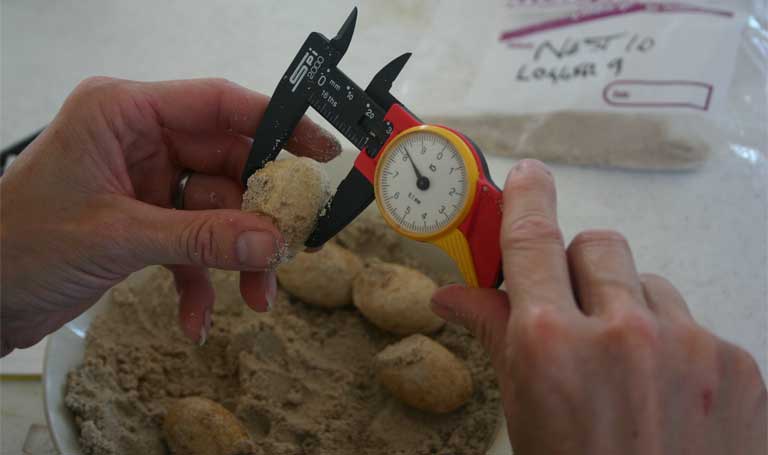
Gerber and his team were invited to TCI following extensive work in the Cayman Islands on its endemic rock iguanas. The researchers evaluated TCI iguana populations on over 130 landmasses throughout the Turks and Caicos Islands. Ongoing studies focus on diet and nutrition, nesting and incubation, population dynamics, genetic variation, behavior, and physical characteristics of the iguanas.
Gerber’s team also developed a creative and unique tagging system for rock iguanas — colored glass beads, coded to numbers, are laced on a wire through a small piercing in the neck crest, allowing identification by sight. This alleviates the stress and possible injury that can occur at recapture.
Much of the fieldwork, moving from cay to cay, is done by boat and based on the R.V. Cyclura, the team’s retrofitted research craft. The Cyclura is approaching half a century in age, and in is need of a daunting quarter of a million dollar replacement.
Reintroduction offers hope
The San Diego team, working in collaboration with the Turks and Caicos Islands government and Turks and Caicos National Trust, has also been involved in the reintroduction of the rock iguanas to cays where they had been historically extirpated.

This requires that scientific fieldwork be supplemented by public education about the rock iguana, along with local capacity building among the islanders on the various cays. Successful reintroduction only happens with the support of the human population that remains after the scientists go home, ensuring that predatory mammals are removed and stay absent.
Five new thriving populations of rock iguanas have been established to date; the reptiles coexisting peacefully with the large numbers of nesting seabirds on the remote cays within Protected Areas. More are planned.
These pioneering iguana colonies were established using adults removed from stable source populations, including some relocated from the development zones on Big Ambergris Cay. Tagged and released onto their new home cays, they bred within the first year. Surprisingly, offspring in the relocated populations were found to mature faster than established populations, with breeding size being attained in as little as two years. It normally takes about five to seven years for Cyclura carinata to attain maturity.
With each female rock iguana laying five to ten eggs from April to May, and the hatchings appearing just two months later, the relocated iguana populations grew quickly. C. carinata breeding coincides with the rains before hurricane season, guaranteeing unlimited tender new plant growth and abundant small fruit for the newest generation of hatchlings to eat.
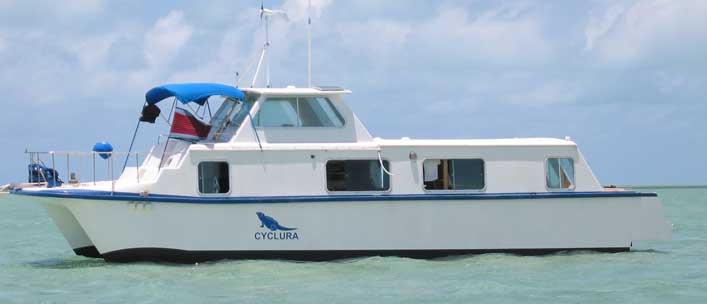
Translocations were carried out only after careful genetic analysis was made of all populations. The analysis proved important, as evidence suggests that there may be enough genetic variance in the overall population to break it into two further subspecies. This is a move that will likely strengthen genetic resilience and provide the animals with better adaptability to habitat alterations such as those brought by climate change.
The cost of paradise
Iguana ecological research and translocations consume major economic resources, with over half a million US dollars having gone into the work by the San Diego Zoo since 2000.
Additional contributions and grants come from diverse sources, including the Offield Family Foundation, International Iguana Foundation, Mohamed bin Zayed Species Conservation Fund, Disney Wildlife Conservation Fund, Steve and Carol Weinberg Foundation, Fort Worth Zoo, and Mississippi State University. General operating costs for the research top $30,000 per year.
According to Gerber, it’s money well spent. “TCI rock iguanas are important browsers and seed dispersers, capable of reaching extraordinary densities in undisturbed habitats, and are critical to the maintenance and perpetuation of native plant communities. Unfortunately, due to increasing human development and the introduction of mammalian predators and competitors, these iguanas, once found throughout the 200+ islands comprising the Turks and Caicos, now occupy less than 5% of their historic range.”
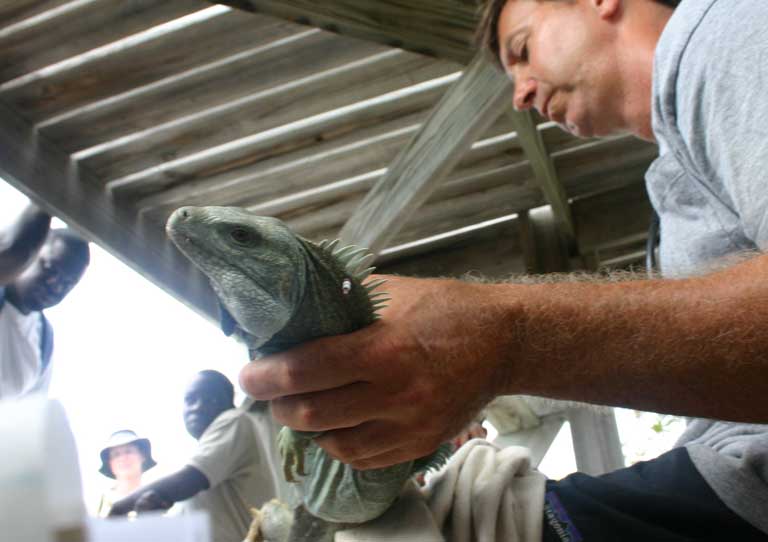
The iguanas’ ecological role makes them a keystone species on which other animal and plant communities depend. Their fate is directly linked to the fate of other animal species within the web of life on the Turks and Caicos Islands.
A “Belonger”
The rock iguana also holds a significant place in the culture of these islands. In decades past, the reptiles were preyed on as a food source; particularly in lean times. Fortunately for the reptiles, the tradition of eating rock iguanas has lost popularity — due both to a changing human diet and to massive public awareness and education programs focused on the iconic lizards.
A wonderfully successful public awareness campaign themed “Iguanas Are Belongers Too,” presented in schools and churches, has elevated the image of this endemic reptile as a Belonger — a traditional legal term for a citizen of the Turks and Caicos Islands — and as a national symbol.
The construction of environmentally sensitive boardwalk trails on Little Water Cay, a Protected Area managed by the National Trust, has also led to heightened public awareness. The award-winning project is the single most-visited eco-tourism attraction in the Turks and Caicos Islands.

The reptilian population there is still threatened by invasive rats and cats, which arrived recently on hurricane-generated sandbars connecting several islands. The Royal Society for the Protection of Birds (RSPB) is collaborating with the National Trust and Department of Environment & Maritime Affairs to control the invaders. It’s no small task.
But winning against the invading exotics is extremely important to the iguanas and to the myriad tour companies that ferry visitors to this 48-hectare (118-acre) island to experience them. Not only are the iguanas great dune gardeners, but they are also unlikely job creators, helping to keep the local guides employed within the tourism industry.
Turks and Caicos Islands visitors looking for a day off from the beach, an active excursion, or a diversion from scuba diving, suddenly become avid eco-tourists, and cannot help being captivated when their vessel lands and rock iguanas greet them on the beach.
And the iguanas are good hosts! They’ve become accustomed to tourists walking along the carefully constructed boardwalks — so that burrows are not disturbed — and graciously allow visitors to sidle up to them for close observation and the occasional selfie.

A small entry fee maintains the preserve infrastructure and pays the salaries of wardens who lead tours and answer visitors’ questions. A lucky few may even witness field research up close and personal when Gerber’s team is on-island. But simply seeing the iguanas in their habitat often results in a new found appreciation for the ecosystem and its amazing inhabitants.
Typical tourist comments include references to the movie Jurassic Park, and expressions of envy at the life these lizards lead — inhabiting some of the world’s most exclusive beachfront property, leisurely sunning after enthusiastically stuffing themselves with the freshest tropical fruits, and having no other responsibility besides digestion and a little haphazard gardening.
These beach bums will continue to provide essential long-term ecological services to the Turks and Caicos Islands only so long as their human neighbors and conservation allies remain committed to their survival. It is hoped that they will thrive, and that there will never be an opening created for the dream job of being a Turks and Caicos Rock Iguana lounging within earshot of the surf, serving as an environmental ambassador and dune gardener extraordinaire.













